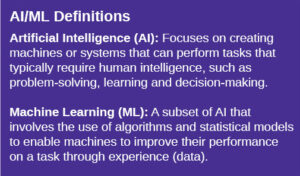By Jonathan Welch, head of Data Science at Albert Invent; Jason Killgore, project leader and materials research engineer at the National Institute of Standards and Technology (NIST)
It’s hard to find a more loaded, divisive and buzzworthy topic in business today than artificial intelligence (AI) and machine learning (ML). Some people love its promise of automation, efficiency and data-driven insights. Others fear its impact on employment and the way we work. Whatever boat you are in, there’s one thing for sure: AI/ML is coming to the UV-curable coatings and additive manufacturing industry; it’s just a matter of how. And the good news is we get to decide a lot of that “how” together.
 Practically overnight, AI went from being a topic reserved for sci-fi movies and data enthusiasts to being discussed in our conference rooms and dinner tables. When something becomes that hot that fast, it’s easy to get ahead of ourselves and create narratives that aren’t accurate. We heard a lot of those narratives at the PAMA 2023 Workshop we moderated in September. Our hope is to take a step away from the spectacle of AI / ML, explore the realistic expectations and start to map out a reasonable path forward for the UV-curable industry.
Practically overnight, AI went from being a topic reserved for sci-fi movies and data enthusiasts to being discussed in our conference rooms and dinner tables. When something becomes that hot that fast, it’s easy to get ahead of ourselves and create narratives that aren’t accurate. We heard a lot of those narratives at the PAMA 2023 Workshop we moderated in September. Our hope is to take a step away from the spectacle of AI / ML, explore the realistic expectations and start to map out a reasonable path forward for the UV-curable industry.
The Hype is Real: A New Frontier for Scientific Exploration
While the hype of AI has been intense, it is for good reason. Its potential is exciting, especially given where we are at as an industry. The problems we are solving are multi-dimensional and complex. Our products are used in increasingly higher-value applications like dentistry, prosthetics, human tissue, electronics and material science, which means we have exponentially more variables to consider – thousands of different raw materials and chemistries, and multitudes of tunable parameters in the equipment used to process them.
The number of possible material formulations and processing conditions is immense, and there’s simply no way the human brain can holistically capture all those degrees of freedom at once. That’s where the computational muscles of AI and ML come into play. In this sense, AI and ML are not just about making things faster; they are about capturing and refining our understanding of materials and processing techniques so we can open doors to new applications and innovation in our industry.
Now, the question many of you may be asking is: Isn’t that the scientist’s job? It is, and it will continue to be – only with AI and similar technologies, you will have an even more powerful and resourceful assistant. One of the biggest misconceptions is AI will replace scientists. On the contrary, AI is most effective when combined with rigorous scientific domain expertise.
When it comes to materials discovery, it is very unlikely that AI will tell you something it’s never seen or observed before – it can only tell you what is probable given the observations it was trained on. For example, if you give an ML model a set of data where all of the experiments were performed around room temperature, and then you ask it to tell you what will happen at 400° F, you will not get a reasonable answer. ML, as a rule, does not extrapolate well. That’s why the human element is so important. You do the novel science – AI and ML are tools to give you different lenses through which to view your problem so that you can better know what is actually known and spend more time being creative and finding ways to push the boundaries. For example, applying Bayesian optimization to formulation and manufacturing processes has been successful in the pharma industry 1 and can help to navigate the complex design space while simultaneously directing experiments towards key material properties.
Reality Check: A Lot of Work to Do
With that said, getting to the point where our industry can leverage technologies like AI and ML to accelerate and amplify the science will not happen overnight. We have a lot of work to do. AI and ML are not magic wands; they are tools. The effectiveness of AI and ML depends on the quantity of data, the quality of data and the willingness of industry professionals to embrace and adapt to these new technologies. Let’s tackle these one by one.
1. Quantity of Data: For AI and ML models to work, they need a lot of meaningful data on which to train them. Otherwise, you run the risk that the AI will attempt to extrapolate and end up hallucinating something nonsensical. In photopolymer AM, the voxelated and layer-wise nature of the fabrication provides opportunities for considerable process investigation (a single part can have billions to trillions of voxels individually controlled), but methods of extracting meaningful data from those voxels still are in their infancy. 2 Likewise, combinatorial chemistry and advanced robotics provide means of exploring vast formulation space. Still, high throughput tests that can probe the most important properties (mechanical, chemical, environmental) require further development. As a community, we can work together to build large foundational datasets based on well-known formulations. These data sets then can be augmented to address specific customer or industry needs.
2. Quality of Data: The data means nothing if it’s not clean, structured and organized in a way the models can process it. For that to happen, it’s critical to start collecting data in a standardized way that follows FAIR (findable, accessible, interoperable and reusable) principles. That means working together as a scientific and industrial community to come up with these standards and best practices so the data is organized well enough that it can be shared when working toward a common goal. This also will mean that deploying data engineering best practices and systems to get the data you have, and continue to collect, into a clean and structured form will be critical.
3. Willingness to Experiment and Learn: If you haven’t tried one of the public AI tools yet (ChatGPT, Bard, etc), give it a go and ask it to explain the potential to the UV-curables industry. Then follow up and ask it how to actually do one of the studies it suggests – ask it to help you learn how to write the code to clean and process your data, how to interpret the results of an ML model, and most importantly, to explain the pitfalls and biases that you need to watch out for when utilizing ML in your workflow.
The Path Ahead
To this end, if there’s one outcome achieved as a result of this article, it would be to see our industry peers begin experimenting more with the technology. Despite the hype, it has brought us a plethora of options that merit getting our hands dirty with AI and ML. It takes seconds to hop onto ChatGPT and begin playing around. And we believe that when you do, you will begin getting curious about how else you can leverage the technology in your work and what you can do to make it better.
The AI and ML journey in our industry is evolving at a rapid pace, and we look forward to continuing the conversation. To that end, along with the many discussions taking place at industry conferences, RadTech is building out an ML workgroup to provide education and pilot studies that we would love for you to join. Please reach out and collaborate with other industry leaders on how to leverage the technology and turn AI from a buzzword into a powerful force for positive transformation for our organizations and our customers.
References
- Sano, S., Kadowaki, T., Tsuda, K. et al. Application of Bayesian Optimization for Pharmaceutical Product Development. J Pharm Innov 15, 333–343 (2020). https://doi.org/10.1007/s12247-019-09382-8
- Killgore, J.P. , Kolibaba, T.J., Caplins, B.W. et al. A Data-Driven Approach to Complex Voxel Predictions in Grayscale Digital Light Processing Additive Manufacturing Using U-Nets and Generative Adversarial Networks. Small (2023). https://doi.org/10.1002/smll.202301987
 Jason Killgore is a PAMA co-founder and co-leader of the Photopolymer Additive Manufacturing Project at the National Institute of Standards and Technology. He is focused on building a measurement, standards and data infrastructure to ensure success of photopolymer AM in increasingly critical applications.
Jason Killgore is a PAMA co-founder and co-leader of the Photopolymer Additive Manufacturing Project at the National Institute of Standards and Technology. He is focused on building a measurement, standards and data infrastructure to ensure success of photopolymer AM in increasingly critical applications.
 As the head of Data Science at Albert Invent, Jonathan Welch brings over a decade of experience in research, engineering and data science. With a Ph.D. in Applied Physics from Harvard University and a background in statistical and deep learning applications, Welch is passionate about leveraging large data sets in the cloud to drive innovation.
As the head of Data Science at Albert Invent, Jonathan Welch brings over a decade of experience in research, engineering and data science. With a Ph.D. in Applied Physics from Harvard University and a background in statistical and deep learning applications, Welch is passionate about leveraging large data sets in the cloud to drive innovation.
For more information, visit www.pama3d.org, www.nist.gov and www.albertinvent.com.






